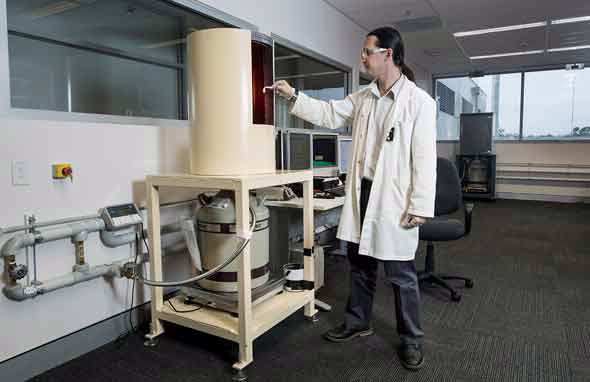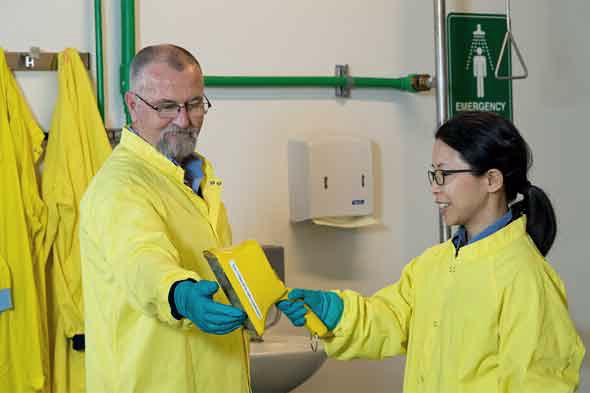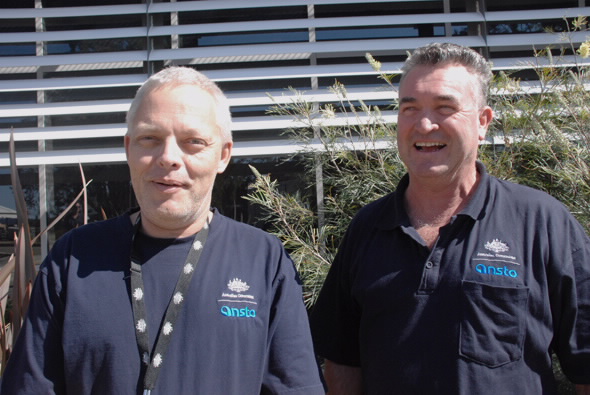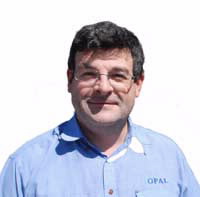5:00pm
Attila Stopic is taking an irradiated sample of a biological organism and using a gamma spectrometer to analyse the elements in the sample. An environmental researcher has provided the marine sample to determine if the organism is getting its nutritional requirements from its feed.
 |
| Neutron Activation scientist Attila Stopic analyses a sample using gamma spectrometry |
The OPAL reactor is used for Neutron Activation Analysis (NAA), a highly sensitive technique that can be used to determine the elements in many types of samples, including soils, minerals, biological, archaeological or high tech manufactured materials.
There are more than 60 elements that emit gamma radiation after being exposed to neutrons in the reactor.
“Because we use solids, it avoids the need to dissolve the sample into a liquid, which can be very difficult to do with some types of samples,” said Neutron Activation Scientist Attila Stopic (pictured above).
Stopic and a technician manage all the short irradiations and spectrometry themselves using a pneumatic system that delivers samples to the reactor and returns the samples to them.
Longer irradiations are managed by the reactor utilisation operators. In a recent project, Stopic is assisting an Italian laboratory with the redefinition of the kilogram by applying NAA to highly purified silicon to measure impurities. Few NAA laboratories around the world have access to the neutron flux required to analyse this type of sample.
6:00pm
The General Manager of Nuclear Operations, Lubi Dimitrovski is presenting Sui Chi Wong with an OPAL Star Award, which recognises her professional prompt and meticulous Health Physics above and beyond assigned responsibilities. The OPAL STAR Award program has been used since 2011 to reward and recognise OPAL staff members as nominated by their peers for safety and performance.
 |
| Sui Chi Wong of the Health Physics team scans Jeffrey Watson 's glove as he has been in the reactor area |
7:00pm
Gerard Quinn and Pieter Baarendse have just finished loading silicon targets into one of the reactors irradiation facilities, where the silicon will be doped with neutrons for several hours to enhance its conductivity.
 |
| Reactor utilisation technicians Pieter Baarendse (left) and Gerard Quinn |
Reactor Utilisation technicians, Gerard Quinn and Pieter Baarendse operate and use several different systems in their daily tasks in reactor operations.
With responsibility for any activity in and around the reactor, they can spend up to four hours in containment, which is a sealed environment.
Wearing the appropriate personal protective equipment, they use a hoist attached to a mobile bridge over the reactor pool to load and unload targets into their respective irradiation facilities located in the reflector vessel.
“Every single thing we lift is a nuclear lift, which comes with consequences. Due diligence and care is taken at all times.
You can’t ever be complacent and you must make a mental adjustment for the work environment,” said Baarendse.
A complex production schedule outlines all daily activity, which takes place over 24 hours when the reactor is operating and it is an exacting timetable. “Every irradiation is time sensitive.
Some people have flexibility with time while working on a project, we have get our irradiations right—down to the second,” said Quinn.
The irradiation of silicon is very precisely timed. Also, irradiated targets start decaying, losing their radioactivity as soon as they are removed from the reactor. For nuclear medicine, this means you have a very narrow window to get the product to the customer.
“We are always very aware that the environment we work in has the potential to contaminate us. But we constantly monitor ourselves with the help of the health physics team.
We find a sense of humour helps us maintain balance in an intense environment,” said Baarendse. Utilisation operators are screened for possible but unlikely radiation exposure following any time in containment.
8:00pm
Kirrily Rule (pictured below) has been collaborating with a materials scientist from the University of NSW Australia with measurements of magnetic excitations on the Taipan instrument. Taipan is located at the OPAL reactor face in the Neutron Guide Hall and uses its neutrons to investigate the collective motion of atoms, such as magnetic interactions. “It is particularly useful in studies of the magnetic ordering in superconducting materials,” said Rule. Neutrons have a spin which can interact with the spin of a magnetic sample.

9:00pm
Matthew Richards is checking the reactor’s 118 page list of operating limits and conditions, as there has been a request for a work on a particular piece on equipment. Although he is familiar with the all aspects of reactor operations, he will confirm that the requested work can be safely performed.
“One of the skills of a shift manager, is being aware of seven jobs that might be underway in the reactor area and anticipating any possible interactions. Nothing should interfere with the routine operations of the reactor” said Shift Manager Matthew Richards, who was a reactor operator for two years and a maintenance manager.
Shift Manager, Matt Richards The goal of staying at power safely is a directive and isotope production is at the forefront of reactor availability.
“The challenge is keeping on top of the game, always thinking about possible interactions. Our process of stop, think act and review applies to everything,” said Richards.The greater part of the shift is made up of general checks, statutory checks, electrical, power, safety, ventilation, instrumentation and channel checks that might be daily, weekly, monthly, 92 day or at 18 months.
It also involves keeping a daily log, meeting and conferring with the reactor operators; overseeing surveillances and issuing and reviewing permits.
“I really enjoying being part of a great team that keeps the reactor operating,” said Richards.
10:00pm
There will be fewer activities at the reactor than during the day but ANSTO staff will work through the night ensuring Australia’s only nuclear research reactor continues to produce a steady supply of neutrons for many purposes to benefit human health, empower scientific research and support industry.
Published: 07/09/2016



